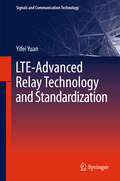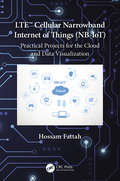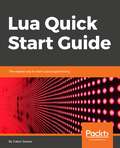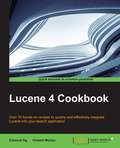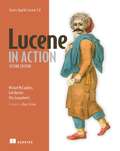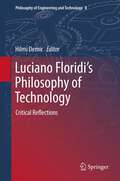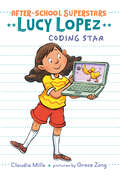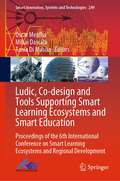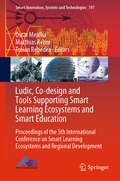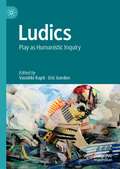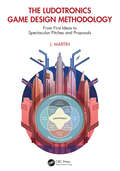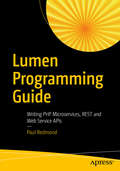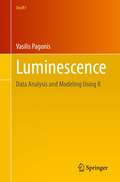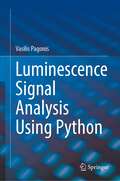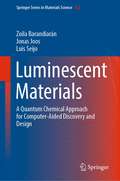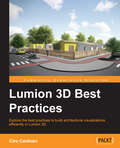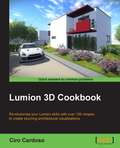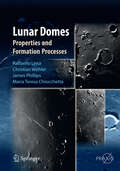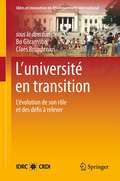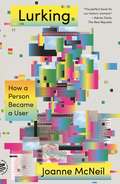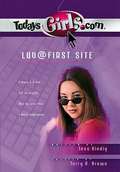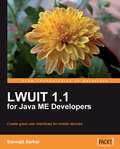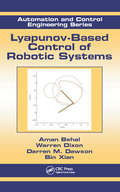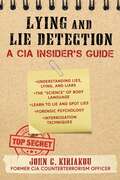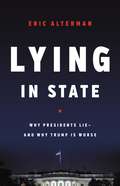- Table View
- List View
LTE-Advanced Relay Technology and Standardization
by Yifei YuanLTE-Advanced relay technology and standardization provides a timely reference work for relay technology with the finalizing of LTE Release 10 specifications. LTE-Advanced is quickly becoming the global standard for 4G cellular communications. The relay technology, as one of the key features in LTE-Advanced, helps not only to improve the system coverage and capacity, but also to save the costs of laying wireline backhaul. As a leading researcher in the field of LTE-Advanced standards, the author provides an in-depth description of LTE-A relay technology, and explains in detail the standard specification and design principles. Readers from both academic and industrial fields can find sections of interest to them: Sections 2 & 4 could benefit researchers in academia and those who are engaged in exploratory work, while Sections 3 & 4 are more useful to engineers. Dr. Yifei Yuan is the Technical Director at the Standards Department of ZTE Inc.
LTE Cellular Narrowband Internet of Things (NB-IoT): Practical Projects for the Cloud and Data Visualization
by Hossam FattahNB-IoT is the Internet of Things (IoT) technology used for cellular communication. NB-IoT devices deliver much better capability and performance, such as: increased area coverage of up to one kilometer; a massive number of devices—up to 200,000—per a single base-station area; longer battery lifetime of ten years; and better indoor and outdoor coverage for areas with weak signal, such as underground garages. The cellular NB-IoT technology is a challenging technology to use and understand. With more than 30 projects presented in this book, covering many use cases and scenarios, this book provides hands-on and practical experience of how to use the cellular NB-IoT for smart applications using Arduino™, Amazon Cloud, Google Maps, and charts. The book starts by explaining AT commands used to configure the NB-IoT modem; data serialization and deserialization; how to set up the cloud for connecting NB-IoT devices; setting up rules, policy, security certificates, and a NoSQL database on the cloud; how to store and read data in the cloud; how to use Google Maps to visualize NB-IoT device geo-location; and how to use charts to visualize sensor datasets. Projects for Arduino are presented in four parts. The first part explains how to connect the device to the mobile operator and cellular network; perform communication using different network protocols, such as TCP, HTTP, SSL, or MQTT; how to use GPS for geo-location applications; and how to upgrade NB-IoT modem firmware over the air. The second part explains the microcontroller unit and how to build and run projects, such as a 7-segment display or a real-time clock. The third part explains how NB-IoT can be used with sensor devices, such as ultrasonic and environmental sensors. Finally, the fourth part explains how NB-IoT can be used to control actuators, such as stepper motors and relays. This book is a unique resource for understanding practical uses of the NB-IoT technology and serves as a handbook for technical and non-technical readers who are looking for practicing and exercising the cellular NB-IoT technology. The book can be used by engineers, students, researchers, system integrators, mobile operators’ technical staff, and electronics enthusiasts. To download the software which can be used with the book, go to: https://github.com/5ghub/NB-IoT About the Author: Hossam Fattah is a technology expert in 4G/5G wireless systems and networking. He received his Ph.D. in Electrical and Computer Engineering from University of British Columbia, Vancouver, Canada in 2003. He received his Master of Applied Science in Electrical and Computer Engineering from University of Victoria, Victoria, Canada in 2000. He completed his B.Sc. degree in Computers and Systems Engineering from Al-Azhar University, Cairo, Egypt in 1995. Between 2003 and 2011, he was in academia and industry, including Texas A&M University. Between 2011 and 2013, he was with Spirent Communications, NJ, USA. Since 2013, he has been with Microsoft, USA. He is also an affiliate associate professor at University of Washington, Tacoma, WA, USA, teaching graduate courses on IoT and distributed systems and collaborating on 5G research and innovations. He has had many patents and technical publications in conferences and journals. He is a registered professional Engineer with the Association of Professional Engineers, British Columbia, Canada. He is the author of the recent book 5G LTE Narrowband Internet of Things (NB-IoT). His research interest is in wireless communications and radio networks and protocols, cellular quality of service, radio resource management, traffic and packet scheduling, network analytics, and mobility.
Lua Quick Start Guide: The easiest way to learn Lua programming
by Gabor SzauerThe easiest way to learn Lua programmingKey FeaturesThe easiest way to learn Lua codingUse the Lua standard libraries and debug Lua codeEmbed Lua as a scripting language using the Lua C APIBook DescriptionLua is a small, powerful and extendable scripting/programming language that can be used for learning to program, and writing games and applications, or as an embedded scripting language. There are many popular commercial projects that allow you to modify or extend them through Lua scripting, and this book will get you ready for that. This book is the easiest way to learn Lua. It introduces you to the basics of Lua and helps you to understand the problems it solves. You will work with the basic language features, the libraries Lua provides, and powerful topics such as object-oriented programming. Every aspect of programming in Lua, variables, data types, functions, tables, arrays and objects, is covered in sufficient detail for you to get started. You will also find out about Lua's module system and how to interface with the operating system.After reading this book, you will be ready to use Lua as a programming language to write code that can interface with the operating system, automate tasks, make playable games, and much more. This book is a solid starting point for those who want to learn Lua in order to move onto other technologies such as Love2D or Roblox.A quick start guide is a focused, shorter title that provides a faster paced introduction to a technology. It is designed for people who don't need all the details at this point in their learning curve. This presentation has been streamlined to concentrate on the things you really need to know.What you will learnUnderstand the basics of programming the Lua languageUnderstand how to use tables, the data structure that makes Lua so powerfulUnderstand object-oriented programming in Lua using metatablesUnderstand standard LUA libraries for math, file io, and moreManipulate string data using LuaUnderstand how to debug Lua applications quickly and effcientlyUnderstand how to embed Lua into applications with the Lua C APIWho this book is forThis book is for developers who want to get up and running with Lua. This book is ideal for programmers who want to learn to embed Lua in their own applications, as well as for beginner programmers who have never coded before.
Lucene 4 Cookbook
by Vineeth Mohan Edwood NgThis book is for software developers who are new to Lucene and who want to explore the more advanced topics to build a search engine. Knowledge of Java is necessary to follow the code samples. You will learn core concepts, best practices, and also advanced features, in order to build an effective search application.
Lucene in Action
by Otis Gospodnetic Erik Hatcher Michael McCandlessWhen Lucene first hit the scene five years ago, it was nothing short ofamazing. By using this open-source, highly scalable, super-fast search engine,developers could integrate search into applications quickly and efficiently.A lot has changed since then-search has grown from a "nice-to-have" featureinto an indispensable part of most enterprise applications. Lucene now powerssearch in diverse companies including Akamai, Netflix, LinkedIn,Technorati, HotJobs, Epiphany, FedEx, Mayo Clinic, MIT, New ScientistMagazine, and many others.Some things remain the same, though. Lucene still delivers high-performancesearch features in a disarmingly easy-to-use API. Due to its vibrant and diverseopen-source community of developers and users, Lucene is relentlessly improving,with evolutions to APIs, significant new features such as payloads, and ahuge increase (as much as 8x) in indexing speed with Lucene 2.3.And with clear writing, reusable examples, and unmatched advice on bestpractices, Lucene in Action, Second Edition is still the definitive guide todeveloping with Lucene. Purchase of the print book comes with an offer of a free PDF, ePub, and Kindle eBook from Manning. Also available is all code from the book.
Luciano Floridi’s Philosophy of Technology
by Hilmi DemirInformation and communication technologies of the 20th century have had a significant impact on our daily lives. They have brought new opportunities as well as new challenges for human development. The Philosopher: Luciano Floridi claims that these new technologies have led to a revolutionary shift in our understanding of humanity's nature and its role in the universe. Florodi's philosophical analysis of new technologies leads to a novel metaphysical framework in which our understanding of the ultimate nature of reality shifts from a materialist one to an informational one. In this world, all entities, be they natural or artificial, are analyzed as informational entities. This book provides critical reflection to this idea, in four different areas: Information Ethics and The Method of Levels of Abstraction The Information Revolution and Alternative Categorizations of Technological Advancements Applications: Education, Internet and Information Science Epistemic and Ontic Aspects of the Philosophy of Information
Lucy Lopez: Coding Star (After-School Superstars #3)
by Claudia MillsTalented Lucy Lopez finds her passion when she joins an after-school coding camp, but can her older sister come to terms with their shared hobby?Third-grader Lucy Lopez and her older sister Elena created the Let's Have Fun Club, where they designed their own badges to put in a handbook and make up lists of things they have to do to earn each one. But now Elena is spending most of her time coding on the computer and Lucy feels left out. She decides to join the after-school coding camp in the hopes that Elena will want to add it to their Let's Have Fun Club activities and it can be something they can do together. But when Lucy proves to be a natural, Elena is none too happy--why does Lucy have to do everything she does?Parents and kids on the hunt for a fun and informative book about coding need look no further! Perfect for fans of Judy Moody, Ivy and Bean, and Clementine, the After-School Superstars series of chapter books features recurring characters, and each book highlights one activity they do at their after-school program. With large black-and-white illustrations, each book includes a bonus activity related to that book's plot. Don't miss the other titles, including Nixie Ness: Cooking Star and Vera Vance: Comic Book Star. Lucy Lopez is being simultaneously released in hardcover and paperback.A Junior Library Guild Selection!
Ludic, Co-design and Tools Supporting Smart Learning Ecosystems and Smart Education: Proceedings of the 6th International Conference on Smart Learning Ecosystems and Regional Development (Smart Innovation, Systems and Technologies #249)
by Tania Di Mascio Óscar Mealha Mihai DascaluThis book brings together the contributions of the 6th International Conference on Smart Learning Ecosystems and Regional Development, which aims at promoting reflection and discussion concerning R&D work, policies, case studies, entrepreneur experiences with a special focus on understanding the relevance of smart learning ecosystems (e.g., schools, campus, working places, informal learning contexts, etc.) for regional development and social innovation and how the effectiveness of the relation of citizens and smart ecosystems can be boosted. This forum has a special interest in understanding how technology-mediated instruments can foster the citizen’s engagement with learning ecosystems and territories, namely by understanding innovative human-centric design and development models/techniques, education/training practices, informal social learning, innovative citizen-driven policies, technology-mediated experiences and their impact. This set of concerns will contribute to foster the social innovation sectors and ICT and economic development and deployment strategies alongside new policies for smarter proactive citizens.
Ludic, Co-design and Tools Supporting Smart Learning Ecosystems and Smart Education: Proceedings of the 5th International Conference on Smart Learning Ecosystems and Regional Development (Smart Innovation, Systems and Technologies #197)
by Óscar Mealha Matthias Rehm Traian RebedeaThis book presents papers from the 5th International Conference on Smart Learning Ecosystems and Regional Development, which promotes discussions on R&D work, policies, case studies, entrepreneur experiences, with a particular focus on understanding the relevance of smart learning ecosystems for regional development and social innovation, and how the effectiveness of the relation of citizens and smart ecosystems can be boosted. The book explores how technology-mediated instruments can foster citizens’ engagement with learning ecosystems and territories, providing insights into innovative human-centric design and development models/techniques, education/training practices, informal social learning, innovative citizen-driven policies, and technology-mediated experiences and their impact. As such, it will inspire the social innovation sectors and ICT, as well as economic development and deployment strategies and new policies for smarter proactive citizens.
Ludics: Play as Humanistic Inquiry (Studies In Surrealism Ser.)
by Vassiliki Rapti Eric GordonThis book establishes play as a mode of humanistic inquiry with a profound effect on art, culture and society. Play is treated as a dynamic and relational modality where relationships of all kinds are forged and inquisitive interdisciplinary engagement is embraced. Play cultivates reflection, connection, and creativity, offering new epistemological directions for the humanities. With examples from a range of disciplines including poetry, history, science, religion and media, this book treats play as an object of inquiry, but also as a mode of inquiry. The chapters, each focusing on a specific cultural phenomenon, do not simply put culture on display, they put culture in play, providing a playful lens through which to see the world. The reader is encouraged to read the chapters in this book out of order, allowing constructive collision between ideas, moments in history, and theoretical perspectives. The act of reading this book, like the project of the humanities itself, should be emergent, generative, and playful.
The Ludotronics Game Design Methodology: From First Ideas to Spectacular Pitches and Proposals
by J. MartinThis book supports readers to transition to more advanced independent game projects by deepening their understanding of the concept development process. It covers how to make concepts sufficiently viable, ambitious, and innovative to warrant the creation of a polished prototype in preparation of a publisher pitch. The book is divided into six sections. After a brief tutorial (Preliminary Phase), readers embark on a journey along the book’s methodology. They travel through successive conceptual phases (Preparations, Procedures, Processes, and Propositions); advance through levels and action beats in each of these phases; master challenges (conceptual tasks) and overcome level bosses (design decisions) that become successively harder; collect items (fulfilled documentation tasks); and “win” the game by having progressed from a raw, initial idea to a full-fledged, polished game treatment. This book is designed to support junior and senior year BA or MA students in game design programs, as well as novice indie developers and those in the early stages of their game design career.
Lumen Programming Guide
by Paul RedmondLearn to write test-driven microservices, REST APIs, and web service APIs with PHP using the Lumen micro-framework, from the now popular Laravel family. This book shows you how testing APIs can help you write bullet-proof web application services and microservices. In the Lumen Programming Guide you will learn how to use Lumen—a micro-framework by Laravel—to write bullet-proof APIs. Lumen helps you write productive, maintainable APIs using modern application design. You will learn how to write fully-tested APIs and understand essential Lumen concepts used to build a solid foundation for writing API projects.What You Will LearnMaintain your API's database structure through built-in database migrationsWrite tests with factory data in a test databaseRespond with consistent data output in JSONDeal with PHP exceptions by using JSON responsesCreate, read, update, and delete REST resourcesRepresent model associations in API responsesBuild a solid foundation for writing tests with PHPUnit and MockeryValidate data Who This Book Is ForPHP developers with no Laravel experience. Only a basic understanding of HTTP and writing PHP applications is needed to get started.
Luminescence: Data Analysis and Modeling Using R (Use R!)
by Vasilis PagonisThis book covers applications of R to the general discipline of radiation dosimetry and to the specific areas of luminescence dosimetry, luminescence dating, and radiation protection dosimetry. It features more than 90 detailed worked examples of R code fully integrated into the text, with extensive annotations. The book shows how researchers can use available R packages to analyze their experimental data, and how to extract the various parameters describing mathematically the luminescence signals. In each chapter, the theory behind the subject is summarized, and references are given from the literature, so that researchers can look up the details of the theory and the relevant experiments. Several chapters are dedicated to Monte Carlo methods, which are used to simulate the luminescence processes during the irradiation, heating, and optical stimulation of solids, for a wide variety of materials. This book will be useful to those who use the tools of luminescence dosimetry, including physicists, geologists, archaeologists, and for all researchers who use radiation in their research.
Luminescence Signal Analysis Using Python
by Vasilis PagonisThis book compiles and presents a complete package of open-access Python software code for luminescence signal analysis in the areas of radiation dosimetry, luminescence dosimetry, and luminescence dating. Featuring more than 90 detailed worked examples of Python code, fully integrated into the text, 16 chapters summarize the theory and equations behind the subject matter, while presenting the practical Python codes used to analyze experimental data and extract the various parameters that mathematically describe the luminescence signals. Several examples are provided of how researchers can use and modify the available codes for different practical situations. Types of luminescence signals analyzed in the book are thermoluminescence (TL), isothermal luminescence (ITL), optically stimulated luminescence (OSL), infrared stimulated luminescence (IRSL), timeresolved luminescence (TR) and dose response of dosimetric materials. The open-access Python codes are available at GitHub.The book is well suited to the broader scientific audience using the tools of luminescence dosimetry: physicists, geologists, archaeologists, solid-state physicists, medical physicists, and all scientists using luminescence dosimetry in their research. The detailed code provided allows both students and researchers to be trained quickly and efficiently on the practical aspects of their work, while also providing an overview of the theory behind the analytical equations.
Luminescent Materials: A Quantum Chemical Approach for Computer-Aided Discovery and Design (Springer Series in Materials Science #322)
by Zoila Barandiarán Jonas Joos Luis SeijoThis book describes a unique combination of quantum chemical methods for calculating the basic physical properties of luminescent materials, or phosphors. These solid inorganic materials containing an optically active dopant are key players in several major fields of societal interest, including energy-efficient lighting, solar cells, and medical imaging. The novel ab initio methods described in this book are especially designed to target the crowded and complex electronic excited states of lanthanide activators in inorganic solids. The book is well suited to both new and experienced researchers alike and appeals to a broad range of theoretical and experimental backgrounds. The material presented enables an adept understanding of elaborate calculations, which, in tandem with experiments, give essential insight into difficult luminescence problems and quandaries, thus fully preparing the reader for an educated search for new functional luminescent materials
Lumion 3D Best Practices
by Ciro CardosoThis book is designed for advanced Lumion users who wish to apply these techniques to their own projects. The reader should be familiar with modeling knowledge and have at least a basic knowledge of a graphics editing program, such as Photoshop or Gimp.
Lumion 3D Cookbook
by Ciro CardosoThis book offers uses practical applications using recipes with step-by-step instructions and useful information to help you master how to produce professional architectural visualizations in Lumion. The cookbook approach means you need to think and explore how a particular feature can be applied in your project and perform the intended task. This book is written to be accessible to all Lumion users and is a useful guide to follow when becoming familiar with this cutting-edge real-time technology.This practical guide is designed for all levels of Lumion users who know how to model buildings in 3D and a basic understanding of Lumion, who want to enhance their skills to the next level.
Lunar Domes: Properties and Formation Processes
by Christian Wöhler Jim Phillips Maria Teresa Chiocchetta Raffaello LenaLunar domes are structures of volcanic origin which are usually difficult to observe due to their low heights. The Lunar Domes Handbook is a reference work on these elusive features. It provides a collection of images for a large number of lunar domes, including telescopic images acquired with advanced but still moderately intricate amateur equipment as well as recent orbital spacecraft images. Different methods for determining the morphometric properties of lunar domes (diameter, height, flank slope, edifice volume) from image data or orbital topographic data are discussed. Additionally, multispectral and hyperspectral image data are examined, providing insights into the composition of the dome material. Several classification schemes for lunar domes are described, including an approach based on the determined morphometric quantities and spectral analyses. Furthermore, the book provides a description of geophysical models of lunar domes, which yield information about the properties of the lava from which they formed and the depth of the magma source regions below the lunar surface.
L’université en transition
by Claes Brundenius Bo GöranssonLa mondialisation, l'ère de l'information et l'essor de l'économie du savoir transforment profondément les modalités d'acquisition, de diffusion et de transformation du savoir. Il s'ensuit que la production du savoir a graduellement davantage à voir avec la compétitivité économique et y est plus directement liée. Ce nouvel état de fait signifie également que les universités se sentent de plus en plus poussées à s'adapter aux besoins de la société et de l'économie, qui évoluent sans cesse. En particulier, des pressions croissantes s'exercent sur les établissements d'enseignement supérieur et de recherche des pays industrialisés pour qu'ils définissent et affirment leur nouveau rôle au sein du système national d'innovation. Les établissements des pays en développement, quant à eux, sont appelés à définir le rôle qu'ils joueront afin de soutenir les structures émergentes du système d'innovation. Ce livre examine le rôle des universités et des instituts de recherche nationaux dans le développement économique et social. En réunissant des textes rendant compte d'initiatives et d'innovations dans diverses régions du monde, notamment en Chine, en Europe de l'Est, en Amérique latine, en Scandinavie, en Asie du Sud-Est, en Afrique subsaharienne et en Europe de l'Ouest, l'ouvrage brosse un tableau qui est d'actualité et qui intéressera tant les responsables des politiques et les administrateurs d'universités que les leaders économiques et sociaux et les chercheurs. Bo Göransson et Claes Brundenius sont tous deux affiliés au Research Policy Institute de l'Université de Lund, en Suède. M. Göransson est professeur agrégé et coordonnateur du programme LEAP4D, et M. Brundenius est professeur honoraire.
Lurking: How a Person Became a User
by Joanne McNeilA concise but wide-ranging personal history of the internet from—for the first time—the point of view of the userIn a shockingly short amount of time, the internet has bound people around the world together and torn us apart and changed not just the way we communicate but who we are and who we can be. It has created a new, unprecedented cultural space that we are all a part of—even if we don’t participate, that is how we participate—but by which we’re continually surprised, betrayed, enriched, befuddled. We have churned through platforms and technologies and in turn been churned by them. And yet, the internet is us and always has been.In Lurking, Joanne McNeil digs deep and identifies the primary (if sometimes contradictory) concerns of people online: searching, safety, privacy, identity, community, anonymity, and visibility. She charts what it is that brought people online and what keeps us here even as the social equations of digital life—what we’re made to trade, knowingly or otherwise, for the benefits of the internet—have shifted radically beneath us. It is a story we are accustomed to hearing as tales of entrepreneurs and visionaries and dynamic and powerful corporations, but there is a more profound, intimate story that hasn’t yet been told.Long one of the most incisive, ferociously intelligent, and widely respected cultural critics online, McNeil here establishes a singular vision of who we are now, tells the stories of how we became us, and helps us start to figure out what we do now.
Luv @ First Site (TodaysGirls.com #5)
by Terry Brown Tess KindigWhen Bren develops a crush on a new student, she lies to her friends and on a computer dating questionnaire in order to be matched with him.
LWUIT 1.1 for Java ME Developers
by Biswajit SarkarThis book presents LWUIT through an optimum mix of theory and practice. Classes are described and their applications are demonstrated through a large number of examples. Example code is thoroughly analyzed and many screenshots are included to show what happens when the code is executed. Custom classes are built progressively with a thorough explanation of each step. The book also presents the underlying structural features of LWUIT that are important for skillful use of the API This book is for Java ME developers who want to create compelling user interfaces for Java ME applications, and want to use LWUIT to make this happen
Lyapunov-Based Control of Robotic Systems
by Warren Dixon Aman Behal Darren M. Dawson Bin XianLyapunov-Based Control of Robotic Systems describes nonlinear control design solutions for problems that arise from robots required to interact with and manipulate their environments. Since most practical scenarios require the design of nonlinear controllers to work around uncertainty and measurement-related issues, the authors use Lyapunov's direc
Lying and Lie Detection: A CIA Insider's Guide
by John KiriakouA foolproof guide both to lying and to detecting deception,Lying and Lie Detection: A CIA Insider's Guide will teach you how the pros can tell if and when somebody is lying. People lie all the time. Studies show that the average American lies between six and twenty times a day. Most lies are of the &“little white&” variety or are meant to spare a person&’s feelings. But what about the big lies? What about the consequential ones? You have a right to know when somebody is lying to you. Now, imagine if you had the tools to spot a lie from the truth—a guide to perfect your sixth sense. Whether it's finding out if you truly got the job, unmasking an infidelity, or a simple recommendation, you will no longer have to spend hours, days, or even weeks pondering about it. Through the easy-to-follow instructions and professional anecdotes in Lying and Lie Detection: A CIA Insider's Guide, you&’ll learn to lie and spot lies from John Kiriakou, a former CIA counterterrorism officer and senior investigator for the Senate Foreign Relations Committee responsible for the capture of Abu Zubaydah.Remember, CIA operations officers are trained to lie. They lie all the time. When they are working undercover, they are actually living a lie. With the CIA as a teacher, you&’ll learn how to tell.
Lying in State: Why Presidents Lie -- And Why Trump Is Worse
by Eric AltermanThis definitive history of presidential lying reveals how our standards for truthfulness have eroded -- and why Trump's lies are especially dangerous.If there's one thing we know about Donald Trump, it's that he lies. But he's by no means the first president to do so. In Lying in State, Eric Alterman asks how we ended up with such a pathologically dishonest commander in chief, showing that, from early on, the United States has persistently expanded its power and hegemony on the basis of presidential lies. He also reveals the cumulative effect of this deception-each lie a president tells makes it more acceptable for subsequent presidents to lie-and the media's complicity in spreading misinformation. Donald Trump, then, represents not an aberration but the culmination of an age-old trend. Full of vivid historical examples and trenchant analysis, Lying in State is essential reading for anyone seeking to understand how we arrived in this age of alternative facts.
